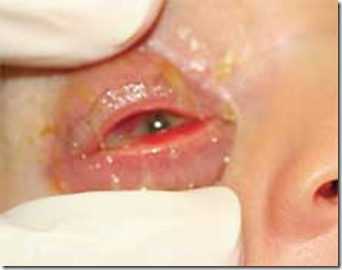Neonatal infections
* Skin lesions in SEM disease appear as macules which progress rapidly to vesicles on an erythematous base in areas of trauma, such as sites of attachment of fetal scalp electrodes, bulb syringe trauma sites on palatal mucosa, and circumcisions.
* Herpes simplex virus CNS disease presents usually between age 2-3 weeks with lethargy and focal seizures . Skin lesions are present in about 50% of patients. Cerebrospinal fluid (CSF) examination reveals pleocytosis and modestly elevated protein. The electroencephalogram is diffusely abnormal.
* Disseminated herpes simplex virus disease in neonates usually mimics severe bacterial infection, often presenting within the first few days of life. Skin lesions are often absent at the onset of illness but 70% of the patients demonstrate skin lesions at some point during the illness. Clinical findings include vascular instability, jaundice, hepatomegaly, and pneumonitis. Death is caused by shock, liver failure, respiratory failure, or neurologic deterioration.
Orolabial herpes simplex virus infections
* Primary herpetic gingivostomatitis results in vesicles and ulcers involving the hard and soft palate, gingiva, tongue, and lips. These lesions are initially vesicular, but rupture fairly rapidly, leaving 1-3 mm, shallow, gray-white ulcers on erythematous bases. Fever and cervical and/or submandibular adenopathy are common.
* Patients with herpes simplex virus pharyngotonsillitis typically present with ulcers and exudates on the posterior pharynx and tonsillar area. Lesions may also be noted on the tongue, buccal mucosa, or gingiva. Fever may last 2-7 days. Cervical adenopathy is common.
* Recurrent orolabial herpetic infection is preceded by a prodrome of pain, burning, tingling, and itching. The prodrome is followed by the emergence of painful vesicles 24-48 hours later. The vesicles evolve into pustules and heal by crusting. Lesions typically appear on the vermillion border of the lip.
Genital infections
* Primary genital herpes appears as macules and papules, followed by vesicles, pustules, and ulcers. Fever and localized inguinal adenopathy are frequently noted. Lesions are typically observed on labia major, labia minora, and mons pubis in females and on the shaft of the penis in males.
* The painful and tender lesions are associated with dysuria and may involve the buttocks, perineum, and vagina. Urinary retention is observed in 10-15% of female patients.
* As many as 25% of women with genital herpes simplex virus have findings suggestive of meningitis.
* Recurrent herpes simplex virus infection causes ulcerating vesicular lesions or merely irritation of the vulva in women.
Herpes simplex virus CNS disease
* Biphasic age predilection is noted occurring in patients aged 5-30 years and older than 50 years.
* Patients typically have malaise, irritability, and nonspecific symptoms lasting 1-7 days followed by acute onset of fever and focal neurologic signs, with signs and symptoms suggestive of temporal lobe involvement.
* CSF analysis reveals pleocytosis with lymphocytic predominance and an increased number of RBCs.
* Electroencephalography typically reveals focal spike and slow-wave abnormalities early in the course of herpes simplex virus encephalitis. A characteristic finding of paroxysmal lateralizing epileptiform discharges (PLEDs) is observed.
* Edema with hemorrhagic necrosis is observed on MRI of the brain.
Herpes simplex virus in the immunocompromised patient
* Patients with primary immunodeficiencies, AIDS, malignancy, malnutrition, burns, and transplant recipients (eg, bone marrow, organs) receiving immunosuppressive therapy can have unusually severe herpes simplex virus infections.
* Severe orolabial infections may begin as typical herpes simplex virus lesions in or around the mouth. Over several days, the papules and vesicles can progress to bullae, frequently with hemorrhagic fluid. These bullae then may evolve into large, chronic, bloody lesions that coalesce and erode into the subcutaneous tissue or deeper tissues.
* Orolabial herpes simplex virus infection may involve contiguous mucosal surfaces to cause herpes simplex virus esophagitis, tracheitis, pneumonitis, or disseminated infection. Patients with esophagitis typically present with fever, retrosternal pain, and odynophagia and patients with pneumonitis present in respiratory failure.
Other herpes simplex virus infections

* Herpes simplex virus infection of the eye presents as blepharitis, follicular conjunctivitis, or keratoconjunctivitis. Signs include corneal or conjunctival injection, watery discharge, lid swelling, and preauricular adenopathy.
* Patients with Mollaret meningitis present with fever, nuchal rigidity, and transitory neurologic findings that accompany meningeal irritation.
